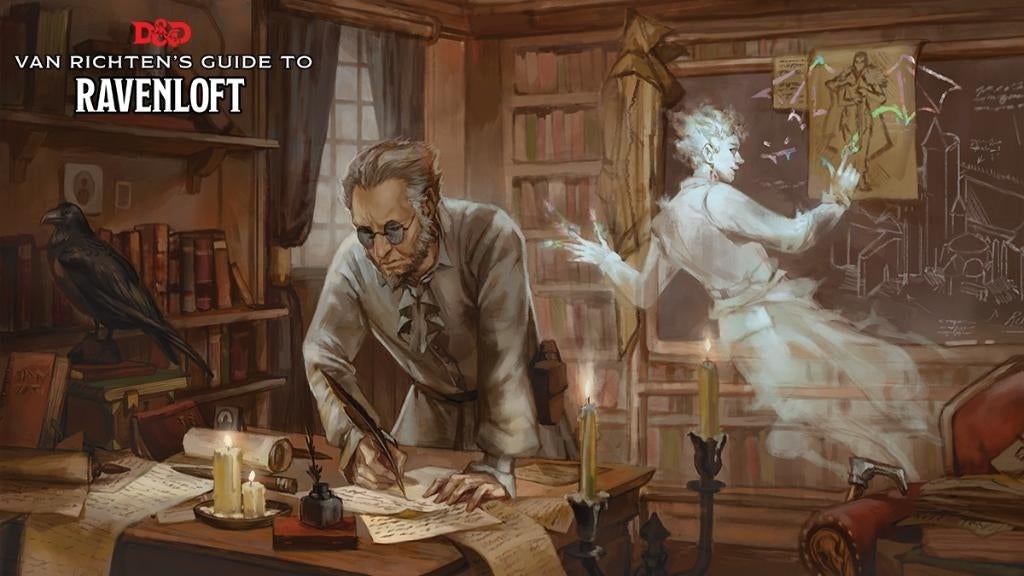Van Richten’s Guide to Ravenloft is not only a major update to the world of Ravenloft, it also presents an interesting approach to building Dungeons & Dragons adventures that could mark a major shift in the ethos of D&D publications. In 1983, Tracy and Laura Hickman introduced the gothic horror-laced world of Ravenloft to Dungeons & Dragons. While Ravenloft was originally created to hold the iconic D&D vampire Strahd von Zarovich, the world eventually expanded to include a patchwork collection of “Demiplanes of Dread,” each of which served as an eternal prison for some sort of foul creature. The current Fifth Edition set of rules for Dungeons & Dragons revisited Ravenloft in Curse of Strahd, a re-telling of the original Ravenloft adventure set in Barovia. Despite not being set in the iconic Forgotten Realms, Curse of Strahd is considered one of D&D’s best “modern” adventures by players and critics alike.
Videos by ComicBook.com
Now, the rest of Ravenloft is “reborn” in Fifth Edition in Van Richten’s Guide to Ravenloft, a campaign-setting book that provides major updates to several popular Domains of Dread in addition to providing new player options and tools for DMs. The book is split into five parts, each of which contains different tools to help bring Ravenloft to life at the table. The first chapter is all about character creation and contains two new subclasses, three new lineages, new backgrounds and trinkets, and a new Dark Gift mechanic that provides players with optional abilities that come at a thematic or mechanical cost. The second section is a chapter on creating a custom Domain of Dread that serves as laying the groundwork for how the world of Ravenloft works. The third chapter is its longest — a gazetteer of sorts that provides detailed multi-page listings for 17 Domains of Dread, brief descriptions of another 22 Domains, and biographies of about a dozen NPCs that could be recurring characters in a Ravenloft campaign. The fourth chapter contains a brief adventure — The House of Lament — as well as a mix of guidance for DMs when running a horror campaign (including real-world safety mechanisms for players) and new mechanics for Curses, Fear and Stress, Haunted Traps, and Survivors. The book ends with a mini-bestiary with 32 new monster statblocks that can be used in any campaign.

The most visible change in Van Richten’s Guide to Ravenloft is how the book approaches the lore of Ravenloft itself. Some Domains and their respective Darklords are given wholesale revisions. For instance, the Domain of Lamordia was originally ruled by Adam, a flesh golem-like creature created by Doctor Victor Mordenheim. In Van Richten’s Guide to Ravenloft, the region is now ruled by Viktra Mordenheim, a mad scientist tormented by her inability to replicate the Unbreakable Heart device that keeps her reborn lover Elise alive, even as Elise flees from her at every turn. Other Domains keep most of their original lore intact — the realm of Mordent, for example, is mostly unchanged save for some minor tweaks to untangle it from the saga of Strahd. Curiously, other Domains keep their original lore but are advanced in other ways. Darkon is now a Domain in decline after the disappearance of the iconic lich Azalin, while Valachan’s new Darklord Chakuna actually replaced the previous Darklord after a gory ritual that resulted in Urik von Kharkov’s death.
Initially, the patchwork nature of how Dungeons & Dragons approached their updates to Ravenloft feels odd, but it’s obvious that most of these changes are designed to streamline the nature of the Domains of Ravenloft. First and foremost, the domains all now function as originally intended: prisons meant to torture specific souls. Many of the original Ravenloft domains featured strange punishments that didn’t necessarily fit the crime of the Darklord. The revised domains are usually a better utilization of the ironic intent that flavors the immortal prisons of Ravenloft. The domains also now include a variety of different horror genres rather than a fixation on gothic horror. Finally, much of the misogynistic, colonialist, or racist elements have been purged out of this new iteration of Ravenloft. Although these changes will likely be the most talked about part of the book in some circles, these changes seem to have occurred naturally during the course of updating Ravenloft to reflect more diverse horror genres and to make the domains conform to Ravenloft’s internal laws.
As a DM, the tools found in Chapter 4 of the book are the most appreciated. Not only does this chapter advise players on how to create a horror game that’s satisfying for your players without crossing any lines, but it also provides some very good mechanical tools for a horror campaign. For instance, the chapter finally provides alternative rules to curses that make them much more powerful in a campaign (previously, curses could be dispelled by any Cleric of 5th level or greater) along with new “Fear and Stress” rules that provide an alternative to the dated “Madness” rules prominent in other horror-themed games. Like other Fifth Edition mechanics, these tools are relatively simple but they do fill an actual need and helps make D&D a little more versatile.

My biggest criticism of Van Richten’s Guide to Ravenloft is how the book mechanically approaches its Darklords and how that relates to the general ethos of these campaign-setting books. None of the book’s Darklords are given updated statblocks, with the justification being that the Darklords are in Ravenloft for their actions as opposed to any special abilities they might have. On a thematic level, this justification is great and it really sets the tone that the Darklords aren’t a problem the players can solve with stabbing. However, given that the one full-length Ravenloft adventure (and frankly, every campaign Wizards of the Coast has produced for Fifth Edition) features a Darklord who is very much a “big bad” meant to be confronted in combat, it feels like Van Richten’s Guide to Ravenloft doesn’t necessarily do enough to support the adventure style it wants players to explore in the game. Players who have been trained to want to fight these Darklords and DMs are going to have to do a lot of work to either temper player expectations or cobble together a statblock that satisfies their players’ desires. Although the book does provide a walkthrough on how to better customize a statblock to meet a campaign’s needs, a lot of DMs (especially those with limited time) aren’t going to be satisfied with how the book approaches monsters and combat in general. Van Richten’s Guide to Ravenloft provides a lot of inspiration for DMs, but it will still take a lot of work to build a satisfying campaign or adventure in Ravenloft, even with this book on the shelf.
Despite being only a 256-page book (making it smaller than the 2019 Eberron: Rising from the Last War campaign setting), I feel that Van Richten’s Guide to Ravenloft will be one of the most-discussed books published by Wizards of the Coast in recent years. There are a lot of interesting design choices and decisions in this book and they mark a potential shift in how the D&D design team (now led by Ray Winninger) approaches Fifth Edition design. These choices range from massive lore overhauls to the very conscious choice not to provide statblocks for any of Ravenloft’s iconic Darklords. This book is going to be divisive, and the loudest voices will likely whine about gender-swapped Darklords or updates to well-known NPCs, but the design elements and the choices of what the design team considers “important” information to include in this book will also likely set the tone for the D&D discourse for months to come.
Ultimately, Van Richten’s Guide to Ravenloft is a very strong addition to the D&D line. It has some good mechanical additions, tons of juicy lore, and gives DMs a foundation to build a Ravenloft campaign around. While it has some frustrating flaws, the book is on par with Explorer’s Guide to Wildemount and is one of the best campaign-setting books released for Fifth Edition. This book resurrects the full potential of Ravenloft for the first time in decades and should launch an era of countless horror-themed campaigns at tables around the world.
Van Richten’s Guide to Ravenloft is available on May 18th. Pre-orders are live on Amazon now. A review copy was provided to ComicBook.com.
Note: If you purchase one of the awesome, independently chosen products featured here, we may earn a small commission from the retailer. Thank you for your support.








